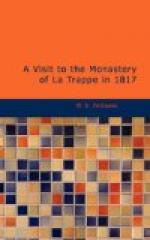I had but a few weeks before seen the tomb of Abelard and Heloise in the Cemetery of Pere la Chaise at Paris, whither it had been recently removed from the Convent of the Augustins, at which latter place I had formerly made the annexed drawing of it. I had likewise been very lately at Argenteuil, once the place of her asylum described by Pope:
In these deep solitudes and awful cells—
and had the same day witnessed the ruins of the house in which Abelard was born, and in which Heloise resided and became a mother, and from whence she used to make frequent visits to this spot: all these circumstances combined, gave the scene before me a most powerful interest. I rose early the next day, anxious to revisit a place which had afforded me such delight the previous evening. Wandering by the beautiful banks of the river, along its green meadows, in a woody recess, I observed the following lines beneath an urn, cut in the rock on which it rested:
Consacrer dans l’obscurite,
Ses loisirs a l’etude, a l’amitie
sa vie,
Sont des plaisirs dignes d’envie;
Etre cheri vaut mieux qu’etre vante!
[Illustration: RUINS OF ABELARD’S HOUSE.]
A little further on, is a stone pillar, with a venerable accacia tree spreading its leaves over it. It has the following Latin inscription:
VII
IM CAESAR
AVGVSTVS
PONTIFEX MAX
VIAM. OLIM
A CONIVINCO
AD LIMONEM
IMP. CAESAR. TRAJ.
ADRIANVS AVG
PM. TRIB. POT.
VIAM AB AVGVSTO
STATAM REFICIT.[8]
[Footnote 8: Auguste etendit jusqu’a La Loire La Gaule Aquitanique, autrefois bornee par la Garonne, et comprit L’Armorique dans la Province Celtique ou Lyonnaise. L’Empereur Adrian, ayant fait depuis une nouvelle distribution des Gaules, divisa La Lyonnaise en deux, et mit L’Armorique dans la seconde; enfin cette Lyonnaise ou Celtique ayant ete encore divisee en deux, Tours devint la Metropole de la troisieme, qui comprenait la Touraine, le Maine, l’Anjou, et la Bretagne.—Histoire de Bret.]
[Illustration: GROTTO of HELOISE at CLISSON.]
[Illustration: TOMB of ABELARD and HELOISE.]
Farther on several large blocks of granite are piled together in so strange and curious a manner, that it must have been the work of Nature alone:—one of them has these beautiful lines carved on it:
O! Limpide Riviere! O Riviere
cherie!
Puisse la sotte vanite
Ne jamais dedaigner ta rive humble et
fleurie!
Que ton simple sentier ne soit point frequente
Par aucun tourment de la vie
Tels que l’ambition, l’envie,
L’avarice, et la faussete!
Un bocage si frais, un sejour si tranquille,
Aux tendres sentiments doit seul servir
d’azile.
Ces rameaux amoureux entrelasses expres
Aux Muses, aux Amours, offrent leur voile
epais;
Et ce cristal d’une onde pure
A jamais ne doit reflechir
Que les graces de la nature
Et les images du plaisir.




